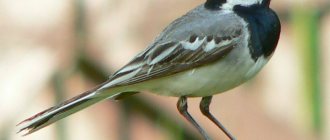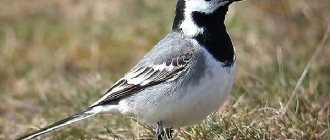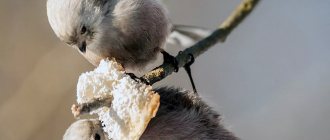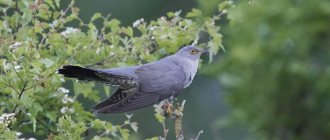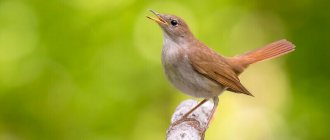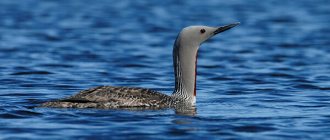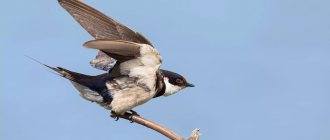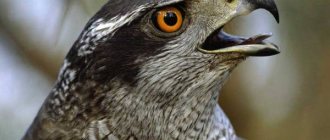- Wild animals
- >>
- Birds
The wagtail is a tiny songbird, at first glance, so fragile and defenseless. But who would have thought that its different species have different plumage, some even very bright. Let's try to describe all the main features of this bird, characterizing not only its appearance, but also its habits, character and habitat.
Origin of the species and description
Photo: Wagtail
Wagtails are songbirds belonging to the same-named bird family Wagtails and the order Passeriformes. This family of birds can be called small, but very widespread throughout the globe, excluding the Pacific islands and Antarctica. There are approximately 60 species of birds in the wagtail family, distributed among five to six genera.
Scientists suggest that the very first wagtail relatives began to live on Earth in the Miocene era, which is from 26 to 7 million years ago. At this time, there was a reduction in forest areas on the planet, and more open spaces appeared, overgrown with small shrubs and grasses, which the wagtails began to inhabit.
Video: Wagtail
It is not difficult to guess why the bird is so named, because it literally constantly “shakes its tail.” The rear tail part of the bird's body is called the tail, and the wagtail, when moving on the ground, tirelessly and dynamically swings its thin and long tail, looking for food.
Interesting fact: The wagtail is the national symbol of Latvia. And back in 2011, the Russian Bird Conservation Union also chose it as a symbol of that year.
Among the people there is a sign that promises good luck and prosperity to the one on whose roof of the house a graceful wagtail has settled. Let's describe some varieties of wagtails to get an idea of what they look like and how they differ from each other.
The white wagtail has a body length of 15 to 19 cm and a weight of about 24 grams. The back is painted gray, and the belly is solemn white. On the white head, a contrasting black cap and a bib of the same color are clearly visible. The tail, as typical of the species, is thin and long.
The yellow wagtail is the smallest of all wagtails, its body length reaches 15 cm, and its weight does not exceed 18 grams. This is an elegant bird with a long tail. The back is gray-green or brownish in color. The wings are ocher with brown spots. The tail is dark brown with visible white feathers. The legs of the bird are painted black. The most important difference of this variety is the extravagant lemon-colored plumage on the abdomen and chest of males, while females have a paler yellow tint. There is no brightness in the colors of the chicks, but brown and gray tones predominate.
The mountain wagtail weighs about 17 grams and its length varies from 17 to 20 cm. The ridge of the bird is gray, the center of the abdomen is yellow, and the sides are white. The tail, like the others, is thin and long. There is a black collar on the neck, which distinguishes this variety from the previous wagtail.
The yellow-headed wagtail weighs about 19 grams and grows up to 17 cm in length. It is similar in appearance to the yellow wagtail, but the bright lemon tint is on the head. The color of the abdomen is either pale yellow or gray.
The black-headed wagtail weighs from 15 to 18 grams, the bird's wingspan reaches 20 cm, and the length of the tail is about 8 cm. The head and neck are painted black, on top the bird is grayish-yellow with green highlights, and on the belly the color is bright yellow or completely white. Brown wings are decorated with white and yellow streaks. In young animals, brown shades with black splashes predominate in color.
The piebald wagtail has a formal black and white outfit. The length of her body is about 20 cm, and her weight is about 27 grams. The dorsal part is black, wide white eyebrows are noticeable above the eyes, and the throat is also white. There is a black cap on the top of the head, the main tone of the abdomen and wings is white.
Appearance and features
Photo: Wagtail bird
Having described the characteristic features of individual varieties of wagtails, it is worth moving on to the general features of wagtails that distinguish them from other birds. In general, wagtails are small, graceful birds, the length of their body ranges from 12 to 22 cm, and their weight does not exceed 30 grams. Wagtails, like real models, are very slender and long-legged, with a neat rounded head. The birds have a short neck, and a thin beak resembles a sharp awl, the beak of which is slightly curved.
The wagtail's dynamic tail is long and slender, consisting of a dozen tail feathers. Looking at it from the side, it is noticeable that it is cut straight, and the two middle feathers are slightly longer than the side feathers. The very first of the flight feathers is much shorter than the second and third. Bird limbs are covered with small scales, and the paws are equipped with rather tenacious fingers with sharp claws. The claw on the back finger is hook-shaped.
This allows you to stay well on the branches. Bird eyes resemble small, round, black beads. It is noticed that the posture of these small birds is very squat when they are on the ground, but it straightens as soon as the wagtail sits on the branches of bushes and grass stems.
Nutrition
These birds feed exclusively on insects. Running deftly, they peck caught spiders, caterpillars, and worms between the blades of grass. They can also tirelessly chase flying insects in the air. When hunting near pastures and livestock, birds catch blood-sucking insects.
The basis of the feed consists of:
- flies;
- butterflies;
- stoneflies;
- beetles;
- spiders;
- mosquitoes;
- dragonflies;
- mayflies.
This is what the wagtail eats.
Where does the wagtail live?
Photo: White Wagtail
As already noted, the distribution area of wagtails is very extensive. Scientists identify approximately 15 species of these birds, which live in Asia, Europe and even on the African continent.
In the territory of the former CIS you can meet five bird species:
- yellowback;
- white;
- mountain;
- yellowhead;
- yellow.
In central Russia, you can most often meet the white wagtail, which is familiar to many.
Interesting fact: It is believed that wagtails come from Eastern Siberia and Mongolia, and it was from these places that they spread throughout Africa and Europe.
If we talk specifically about the habitats of these birds, they are different for different species. The white wagtail occupied Europe, the northern part of the African continent, Asia, and Alaska. Where the climate is warm, it is sedentary, and from more northern regions it flies to Africa for the winter. The mountain wagtail has chosen Eurasia and northern Africa; it is considered a migrant. The yellow wagtail also inhabits Eurasia, Alaska, the northern regions of Africa, and the territories of the North American continent. The yellow-headed wagtail has made its home in the Siberian tundra and migrates to South Asia for the winter.
It is not difficult to guess that the Madagascar bird lives on this island of the same name. The piebald wagtail lives exclusively in sub-Saharan Africa. The black-headed migratory wagtail has inhabited the spaces of Asia and Europe. The long-tailed wagtail has also made its home in the hot African continent.
For living, wagtails prefer open places near various bodies of water. These birds avoid dense forests and are also rarely found in open forest areas. Only the tree wagtail can be considered an exception; it nests in the forest and lives in southeast Asia.
Wagtails choose various regions and landscapes for their place of residence, settling:
- on the banks of rivers, lakes, streams, wetlands;
- in open spaces of wet meadows;
- in areas of tropical and subtropical mountain forests;
- in the vastness of the Siberian tundra;
- in mountainous areas at an altitude of about 3 km;
- close to human habitations.
Now you know where this songbird lives. Let's see what wagtails eat.
Nesting
These birds make nests in a wide variety of places. If wagtails live in a city, they make homes in niches, various crevices formed in buildings, and sometimes settle directly on the ground, preferring places covered from precipitation by fragments of building slabs. In natural conditions, they can nest almost openly, placing nests directly on coastal cliffs.
The most active nest construction occurs in the last month of spring. The material for their arrangement is dry grass, moss, feathers or particles of tow and felt.
What does a wagtail eat?
Photo: Wagtail in Russia
All wagtails can be confidently called insectivores.
Birds snack:
- butterflies;
- spiders;
- caterpillars;
- flies;
- bugs;
- dragonflies;
- mosquitoes;
- ants;
- bedbugs;
- small crustaceans;
- plant seeds and small berries.
Appearing in a new territory, the wagtail noisily and loudly signals this, checking whether the land plot has an owner. If there is one, then the bird retreats without entering into confrontation. In the event that no one shows up, the bird begins to search for food. The bird regularly inspects its isolated area in order to search for insects, and drives uninvited relatives away if there are not many insects in this area. When food is abundant, wagtails are not averse to hunting collectively.
Sometimes the bird grabs its snack right on the fly, but most often it hunts on the ground, moving deftly and quickly and shaking its sophisticated tail. The wagtail's meal looks very interesting; first of all, the bird one by one tears off the wings of the prey (if any), and only then instantly eats it.
Interesting fact: Miniature wagtails bring invaluable benefits to domestic cattle; they often visit pastures, where they feed directly from cows’ backs on horseflies and other blood-sucking reptiles that plague cattle.
Keeping at home
The white wagtail is often kept in captivity. The bird slowly gets used to home conditions, although it is not afraid of people. Sings frequently and melodiously.
To keep it you will need a large cage or a spacious enclosure with perches and crossbars. Also, in addition to the drinking bowl, the wagtail definitely needs a separate container for bathing.
Wagtails are not picky in their diet; they readily eat a mixture for insectivorous birds with the addition of bloodworms or mealworms, a soft mixture (cottage cheese, yolk, carrots, gammarus).
Breeding wagtails in captivity is not practiced.
Features of character and lifestyle
Photo: Wagtail bird
For the most part, wagtails are migratory, but this is determined by the habitat of each specific population. All birds whose range is located further north tend to move to Asia, Southern Europe and Africa for the winter. Species that are endemic to the African continent and Madagascar are classified as sedentary.
All wagtails are very mobile and restless, they are nimble and swift. In a state of rest, they can only be seen during the performance of singing roulades. Then even their dynamic tail stops swaying. The bird's melody is very playful and simple; it consists of an alternation of chirping and soft squeaking.
Often, many wagtails gather near various bodies of water in small flocks or families. Some build their nests on the surface of the ground, others in secluded hollows. These little birds have a bold disposition. Seeing an ill-wisher, they flock from all over the area and begin a collective pursuit of the enemy, shouting very loudly and incessantly. This cry warns other birds of a threat. Swallows often gather together with wagtails.
Migratory wagtails flock south from early to late autumn. The birds do not form very numerous flocks and try to move along bodies of water at night and in the pre-dawn hours. In early spring they return to their native lands.
Interesting fact: People call the wagtail “icebreaker” because it flies from the south during the spring ice drift.
The birds are signaled that it is time to prepare to fly away by their own hormones produced by the pituitary gland. The length of daylight also affects the migratory behavior of birds. Each mature wagtail has a separate area of land where it looks for food. If the food supply becomes too scarce, then the bird looks for a new place.
People consider the wagtail to be very useful, because it famously deals with all kinds of insect pests, causing a lot of inconvenience to humans, cattle and damage to cultivated lands. The wagtail is very trusting of people, so it often settles near their homes. In general, this bird is very sweet, peaceful and not aggressive; it has a completely good-natured character.
Interesting fact: Usually all small birds move along the surface of the earth by jumping, but this is not typical for the wagtail; it moves by running, doing it quickly, so it seems that it is riding on small wheels.
Bird sneezes
If you notice that a wagtail chick is sneezing, as a result of which it spends almost all the time with its beak open, while slightly shaking its tail to the beat, it means that the bird most likely has an upper respiratory tract or lung disease, which must be eliminated immediately contact your veterinarian.
In most cases, a wagtail chick begins to get sick if the box in which it lives is periodically exposed to a drafty area, or there is excessive accumulation of dust around this area, which it inhales. Avoid keeping birds in the kitchen, because most modern cookware is equipped with a Teflon coating, which, when heated, releases harmful substances that can cause a lot of diseases.
If a wagtail chick sneezes, but its behavior remains active and its appetite is good, you need to pay attention to the openings of the nostrils. Narrowing of the nostrils and the formation of a waxy coating indicates hypovitaminosis and, as a result, the need for vitamin supplementation.
Social structure and reproduction
Photo: Wagtail
As already noted, wagtails prefer to live in small flocks or individual families, and their wedding season begins in the spring, about a month after arriving from warm regions. During this period, the gentlemen's outfit becomes more catchy, rich and vibrant, all this is necessary to attract a partner. To impress the young lady, the male bows, dances in a squat, spreads his tail like a fan, walks in circles near the female, spreading his wings to the side.
The next important step is the construction of the nest. To do this, birds together collect twigs, moss, roots, and all kinds of shoots. Usually the nest is cone-shaped and is always located near a water source.
Bird refuges can be found everywhere:
- in wall cracks;
- hollows;
- small earthen holes;
- rocky crevices;
- grooves;
- woodsheds;
- under the roof of houses;
- between the roots of the trees.
Interesting fact: The wagtail nest is very loose and the inside is often lined with animal fur and hair.
The process of laying eggs occurs at the beginning of May; usually there are from 4 to 8 eggs in a clutch. After about a couple of weeks, the babies begin to hatch and are completely helpless. Throughout this incubation period, the future father feeds the female and guards the nest. After the birth of the chicks, both caring parents rush in search of their food. Birds take eggshells away from the nesting site so as not to attract predators. At two weeks of age, the chicks fledge and prepare for their first flights. Gradually they leave their native nesting area, but almost until autumn they gain experience from their parents, and only then begin a completely independent life.
In one summer, wagtails manage to make a couple of clutches. The plumage of the babies has gray, yellowish or black and white shades. Kids learn to fly under the careful supervision of their parents, and in the fall they go to warm countries. In their natural environment, wagtails live about ten years, and in captivity they can live up to twelve.
Natural enemies of wagtails
Photo: Migratory Wagtail
It is not surprising that the small, fragile, graceful wagtail has many enemies who are not averse to feasting on this songbird. Among the predatory animals we can name weasels, martens, stray feral cats, as well as domestic ones. Wagtails living within human settlements often suffer from them. Air attacks are also carried out on a tiny wagtail, because many feathered predators can happily snack on this bird, including crows, cuckoos, hawks, kites, and owls. Owls pose the greatest danger when wagtails move at night during their seasonal migration.
I must say that these birds are quite brave. Feeling a threat, wagtails flock together and begin to drive away the enemy, emitting a strong deafening hubbub, which serves as a warning to other birds. This technique often turns out to be effective, and the frightened ill-wisher retreats. So, due to their small size, in times of danger, birds have to unite and act together.
Sometimes people can harm wagtails without realizing it. It happens like this: when the chicks grow up, they begin to get out of the nest and sit next to it, and passers-by who notice this pick up the babies, thinking that they have fallen out or are sick. This is absolutely impossible to do, because this will cause defenseless babies to die. People also influence birds through their activities, which often leads to a reduction in the permanent habitats of these birds.
Chick development
The wagtail chick, the photo of which is posted above, grows quite quickly, and by the end of July it reaches the size of an adult. The first rare plumage begins to appear in the chicks approximately half a month after birth. Wagtail nests sometimes suffer from attacks by crows and magpies, as well as cats.
Grown chicks need up to 300 servings of live food, as a result of which you can judge the amount of food that you will need to provide to the chick. The daily diet of wagtails consists of crawling invertebrates, after which white wagtails can and do fly away from the nest at significant distances, and collect them in the same areas where other wagtails are looking for it (but not at the same time as them).
Population and species status
Photo: Wagtail bird
The distribution area of wagtails is very extensive; these birds are widely distributed throughout the world. It should be noted that most wagtail species are not vulnerable or endangered. The status of their population states that these birds cause the least concern regarding their numbers, their numbers remain stable, there are no sharp changes down or up, which is good news.
Still, there are certain species of wagtails, the numbers of which have recently decreased, and they cause concern among environmental organizations. Negative factors affecting the bird population include, first of all, anthropogenic ones. People often encroach on wagtail areas, causing the worried birds to stop nesting.
Man is occupying more and more territories for his own needs, displacing birds from their usual habitable places. The expansion of cities and the construction of highways are reducing the area of meadows where wagtails like to live, and this leads to the fact that their population is steadily declining. Every spring, people begin to burn last year’s dead wood, which leads to the death of many insects that wagtails feed on, their food supply becomes scarce, and the birds have to look for new places to live, which also negatively affects the number of birds in need of protection.
Spreading
Area
Most species of wagtails are widespread in Europe and Asia, some live in Africa.
Habitats
This is what a wagtail bird looks like sitting on a wire.
The white wagtail often settles near people. For nesting, these birds prefer areas located near fresh water bodies, lakes and rivers, as well as swampy areas and deciduous forests.
